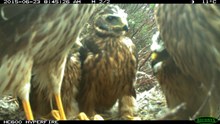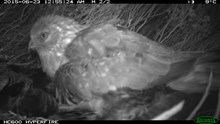07 August, 2015
Cooperation helping hen harriers in Scotland
The Partnership for Action Against Wildlife Crime Scotland (PAW Scotland) ‘Heads Up for Harriers’ project has recorded some notable successes in its first full season, with a total of twelve young birds fledging from three successful nests. A further three nests failed, two as a result of bad weather and another due to fox predation. Members of the public have been providing lots of sightings, and several estates have been working closely with PAW Scotland. All of this is adding to the understanding of the distribution of harriers and why nests fail.
Wendy Mattingley, coordinator of the records coming in from the public, and member of Tayside Raptor Study Group, commented:
“It has been really encouraging to receive a wealth of records from observers visiting the islands and upland areas of Scotland and from local residents taking a genuine interest in the plight of the hen harrier.
“An important result of the project has been the interest shown by some to become more involved in monitoring raptors on a regular basis. Another positive came from contact by one land manager which has led to him working with the local Raptor Study Group and there are plans to erect raptor nest boxes for future breeding seasons.
“A big thank you to everyone so far for their observations and for the excellent co-operation with the Raptor Study Groups. Also many thanks to BTO’s BirdTrack for their continuing support in regularly passing on sightings of hen harriers from around Scotland.”
Hen harriers are now one of Britain’s rarest birds of prey, but still with a relative stronghold on Scotland’s heaths and bogs. Illegal persecution, land use changes resulting in loss of nesting habitat and feeding range, and predation of eggs and young by foxes, crows and other predators have all contributed to the hen harrier’s current situation.
By working with estates to install nest cameras, the Heads Up for Harriers project is gathering evidence of the impact that these different factors on the survival of young birds, with a view to building a better understanding of why nests fail. We can use this information to direct resources, where appropriate, to improve the conservation status of hen harriers in Scotland.
Five upland estates participated in the trial.
Doug McAdam, Chief Executive of Scottish Land and Estates, commented: “Scottish Land & Estates have supported and been active in the Heads Up For Harriers initiative since its inception. Building better understanding and knowledge in what can be a difficult area is vital. We are very pleased that the five member estates we approached to discuss the initiative all volunteered to have nest cameras installed at their Harrier nests in order to learn more about why harrier nests fail. Leaving this to speculation is unhelpful to say the least. After last year’s fantastic breeding season – 30 successful nests in the Hen Harrier Special Protection areas alone producing in excess of 100 young – this season has been much more difficult. We understand that two out of the four monitored nests that produced eggs were deserted and failed, with the most likely explanation being cold wet weather, and underlining why the Scottish harrier population remains fragile. We look forward to building on and expanding this promising start in order to increase understanding and knowledge in the area.”
Project Officer Brian Etheridge, member of Highland Raptor Study Group, has spent the spring and summer months installing state-of-the-art cameras to monitor nesting activities of the harriers. The results have exceeded expectations, but the poor spring weather has hampered both Brian’s efforts and that of the birds he’s charged with monitoring.
Brian said: “We have three successful nests across five sites, producing twelve fledged young harriers. The very cold and wet spring and early summer can badly affect harriers, which are ground nesting birds, and we believe this has accounted for two nest failures, with a further failure the result of fox predation. The surviving young birds are all healthy, and with luck will survive to breeding age”.
Professor Des Thompson of Scottish Natural Heritage (SNH) and Chair of the PAW Scotland Heads Up for Harriers Group, praised everyone involved: “Brian and Wendy, members of the public and the participating estates have been instrumental to this project. The estates have been very accommodating, and have shown a great deal of ownership over “their” harriers, and in some cases actively helped Brian with his work on the ground. Our nest cameras each recorded tens of thousands of images, which provide valuable information on the ecology of hen harriers, their behaviour and the natural threats to their survival. We hope to continue the project next year and widen the scope to include more sites.”
Sightings of hen harriers can be e-mailed to HenHarrier@snh.gov.uk or reported by calling: 07767 671973. Details of places where birds are seen (a six-figure grid reference is best), time and date of sighting and any notes on behaviour – for example hunting low, flying high up, calling (‘chittering’) or skydancing – should be provided where possible. For more information, see http://www.gov.scot/Topics/Environment/Wildlife-Habitats/paw-scotland/what-you-can-do/hen-harriers
ENDS
For more information on the Heads Up for Harriers project, please visit the Heads Up for Harriers web page http://www.gov.scot/Topics/Environment/Wildlife-Habitats/paw-scotland/what-you-can-do/hen-harriers
The Partnership for Action Against Wildlife Crime Scotland (PAW Scotland) has set up a ‘Heads Up for Harriers’ group. It is raising awareness of this majestic bird, determining the current number of hen harriers in Scotland, and identifying specific threats to their survival, so resources can be directed to safeguard and ultimately increase the population. Five Scottish Land and Estates member estates have agreed to participate in the project, which involves the installation of cameras on hen harrier nests. The cameras record images both on the nest and within the immediate area, and it is hoped these will enable a better understanding of the reasons for nesting failure, with a view to directing management to improve hen harrier breeding success.
The Partnership for Action Against Wildlife Crime Scotland (PAW Scotland) represents a wide range of bodies concerned with the prevention and tackling of crimes against wildlife. It includes agencies like Scottish Natural Heritage, Police Scotland and prosecutors as well as organisations representing a wide range of conservation and land management interests. The Executive of PAW Scotland is chaired by the Scottish Minister for the Environment and Climate Change.
Contact information
- Name
- SNH Media
- snhmedia@snh.gov.uk
NatureScot is Scotland's nature agency. We work to enhance our natural environment in Scotland and inspire everyone to care more about it. Our priority is a nature-rich future for Scotland and an effective response to the climate emergency. For more information, visit our website at www.nature.scot or follow us on X at https://x.com/NatureScot
’S e NatureScot buidheann nàdair na h-Alba. Bidh sinn a’ neartachadh àrainneachd na h-Alba agus a’ brosnachadh dhaoine gu barrachd suim a chur ann an nàdar. Tha e mar phrìomhachas againn gum bi nàdar na h-Alba beairteach agus gun dèilig sinn gu h-èifeachdach le èiginn na gnàth-shìde. Tha an tuilleadh fiosrachaidh aig www.nature.scot no air X aig https://x.com/NatureScot



